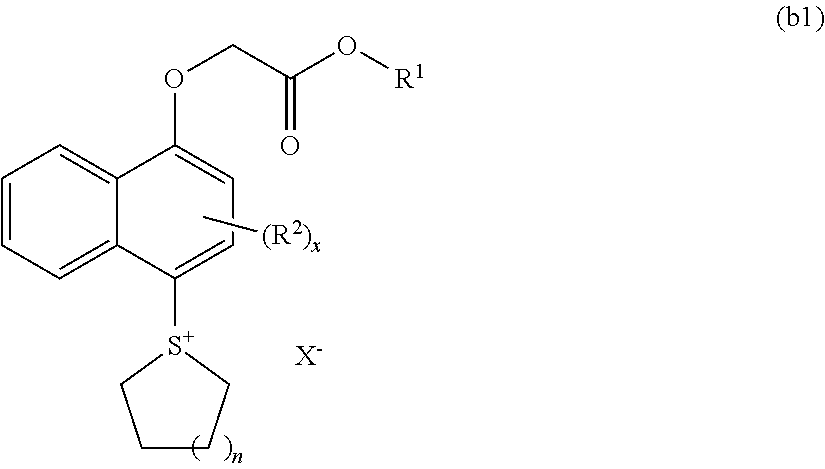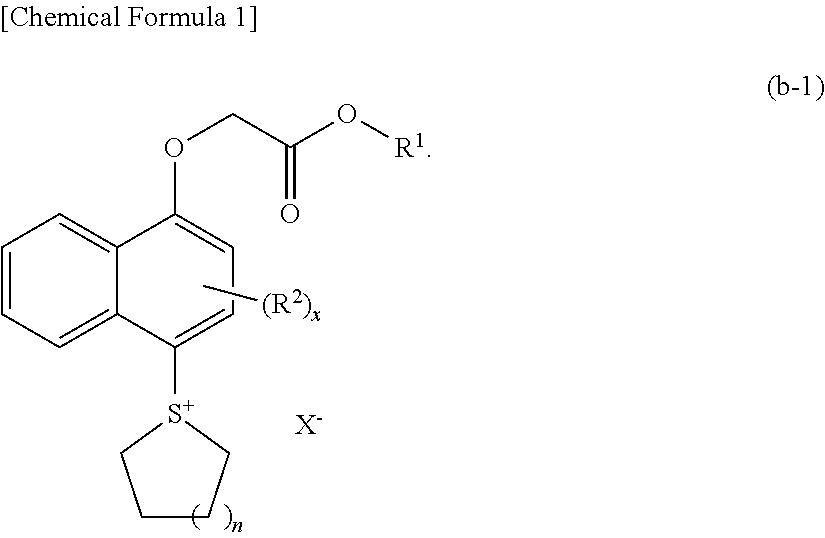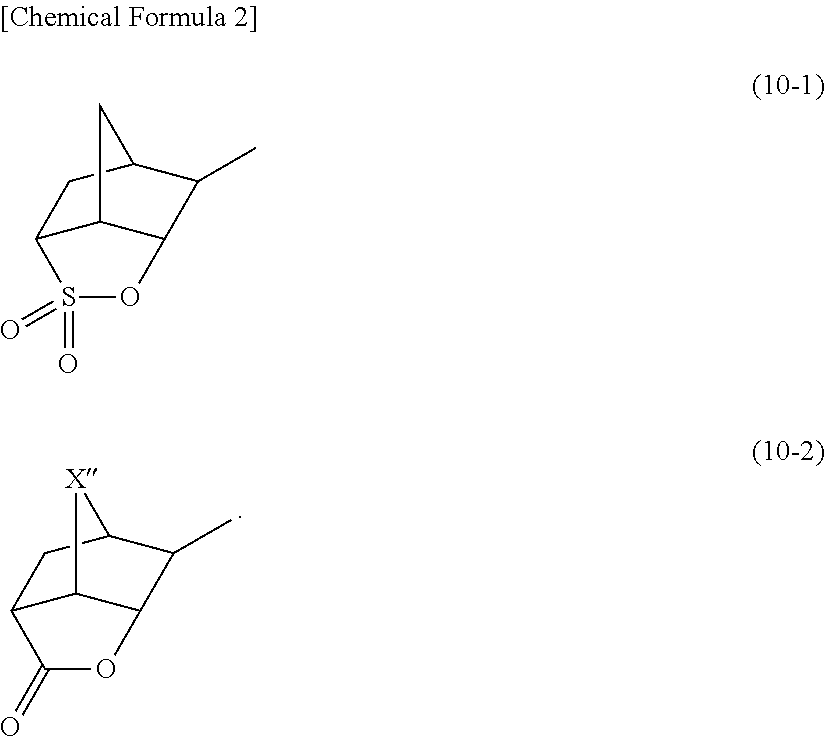Resist composition, method of forming resist pattern, novel compound, and acid generator
a composition and resist material technology, applied in the field of resist composition, can solve the problem that the resist material is essentially unknown in the art, and achieve the effects of improving the resolution of resist materials, excellent lithography properties, and excellent shap
- Summary
- Abstract
- Description
- Claims
- Application Information
AI Technical Summary
Benefits of technology
Problems solved by technology
Method used
Image
Examples
synthesis example 1
Synthesis of Compound (A)
[0551]
[0552]In a nitrogen atmosphere, 25 g of THF was added to 5 g of 1-naphthol, and 23.96 g of potassium carbonate was further added. Then, 6.36 g of methyl bromoacetate was dropwise added to the resulting mixture, and reflux was conducted for 5 hours while stirring. After the stirring, the mixture was separated by filtration, and the filtrate was washed with 37.5 g of water 4 times. Thereafter, the resultant was concentrated using a rotary evaporator, followed by distillation under reduced pressure (0.29 kPa, 152° C.), thereby obtaining 4 g of a compound (A).
[0553]The compound (A) was analyzed by NMR.
[0554]1H-NMR (DMSO, 400 MHz): δ (ppm)=8.23-8.27 (m, 1H, Naph), 7.87-7.91 (m, 1H, Naph), 7.51-7.57 (m 3H, Naph), 7.38-7.51 (m, 1H, Naph), 6.91-6.92 (m, 1H Naph), 1.99 (s, 2H, CH2), 3.72 (s, 3HCH3).
[0555]From the results, it was confirmed that the compound (A) had a structure as shown above.
example 1
Synthesis of Compound PAG-1
[0556]
[0557]To a solution containing 17.63 g of methanesulfonic acid and 1.25 g of diphosphorous pentaoxide was added 1.92 g of the compound (A) and 0.923 g of tetramethylene sulfoxide at 25° C. After stirring at 25° C. for 3 hours, the reaction liquid was dropwise added to a solution containing 26.44 g of t-butylether and 34.37 g of water. After washing by liquid separation, the aqueous phase was washed with 26.44 g of t-butylether twice. To the obtained aqueous phase was added 55 g of dichloromethane and 3.1 g of a compound (1), followed by stirring for 1 hour. After the stirring, the organic solvent phase was washed with 27.5 g of a 1% HCl solution, followed by washing with 27.5 g of water 3 times. The resultant was concentrated and solidified, thereby obtaining 2.82 g of a compound PAG-1.
[0558]The compound PAG-1 was analyzed by NMR.
[0559]1H-NMR (DMSO, 400 MHz): δ (ppm)=8.38-8.45 (m, 2H, Naph), 8.12-8.15 (m, 2H, Naph), 7.76-7.93 (m 2H, Naph), 7.18-7.03 ...
example 2 to 22
Synthesis of Compounds PAG-2 to PAG-22
[0562]The same procedure as in Example 1 was performed, except that the compound (M+X−) was changed to a compound shown in Tables 1 to 8 (equimolar amount). In this manner, products having an anion and a cation as shown in Tables 1 to 8 (compounds PAG-2 to PAG-22) were obtained. Each of the obtained compounds was analyzed by NMR. The results are shown in Tables 1 to 8. In Tables 1 to 8, “↑” indicates that the cation of the compound PAG-2 to PAG-22 is the same as that of the compound PAG-1.
TABLE 1Ex-am-Com-SaltplepoundNMRM+X−CationAnion1PAG- 11H-NMR (DMSO-d6, 400 MHz): δ (ppm) = 8.42 (m, 2H, ArH), 8.17 (d, 1H, ArH), 7.78-7.91 (m, 2H, ArH), 7.23 (d, 1H, ArH), 5.26 (s, 2H, CH2), 4.78 (m, 1H, CH), 4.66 (t, 1H, CH), 3.75- 4.19 (m, 8H, SCH2 + CH3 + CH),, 3.34 (m, 1H, CH), 1.73-2.60 (m, 9H, CH + SCH2CH2 + CH2),, 19F-NMR (DMSO-d6, 376 MHz): δ (ppm) = −107.7.2PAG- 21H-NMR (DMSO-d6, 400 MHz): δ (ppm) = 8.42 (m, 2H, ArH), 8.17 (d, 1H, ArH), 7.78- 7.91 (m,...
PUM
| Property | Measurement | Unit |
|---|---|---|
| temperature | aaaaa | aaaaa |
| pressure | aaaaa | aaaaa |
| thickness | aaaaa | aaaaa |
Abstract
Description
Claims
Application Information
 Login to View More
Login to View More - R&D
- Intellectual Property
- Life Sciences
- Materials
- Tech Scout
- Unparalleled Data Quality
- Higher Quality Content
- 60% Fewer Hallucinations
Browse by: Latest US Patents, China's latest patents, Technical Efficacy Thesaurus, Application Domain, Technology Topic, Popular Technical Reports.
© 2025 PatSnap. All rights reserved.Legal|Privacy policy|Modern Slavery Act Transparency Statement|Sitemap|About US| Contact US: help@patsnap.com



